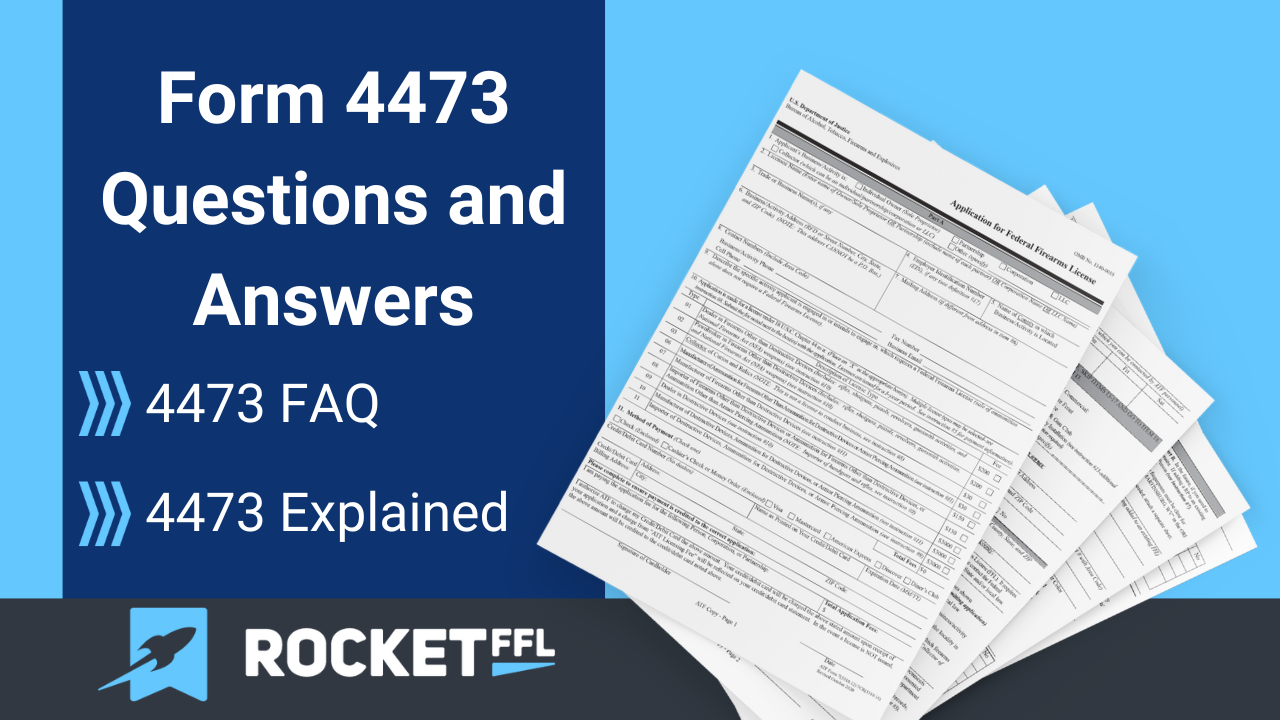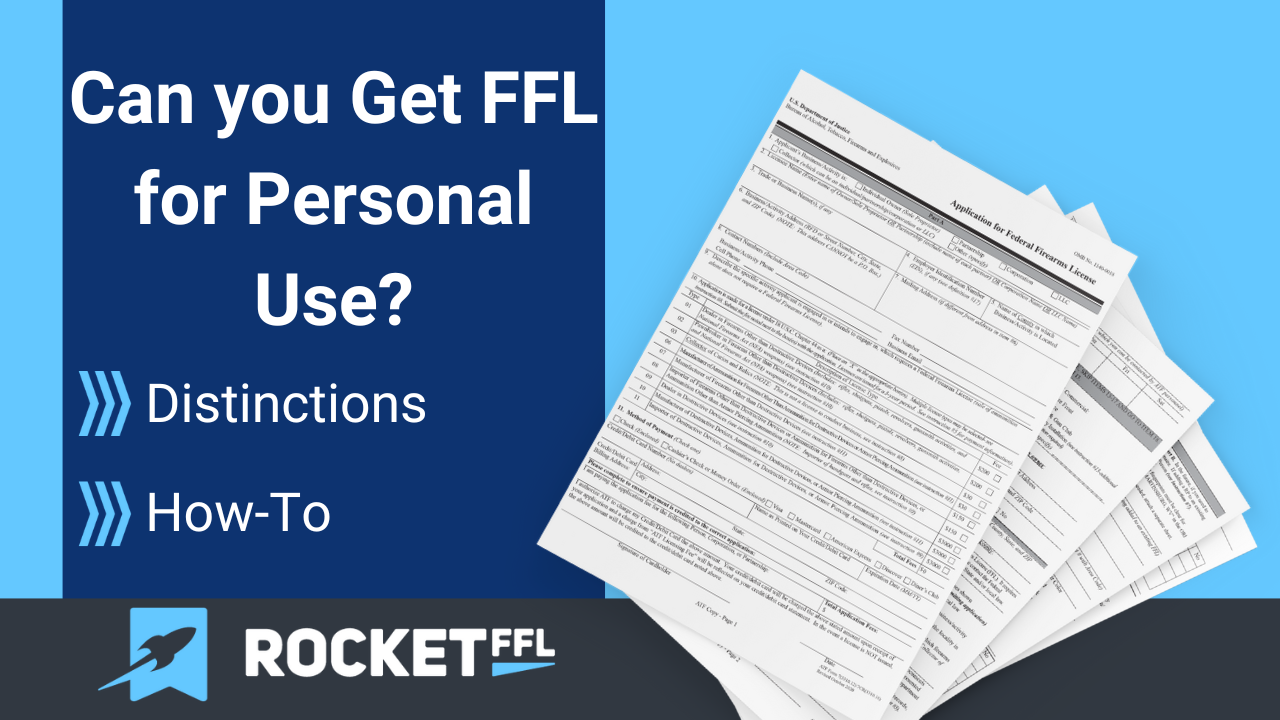There a different types of FFL to choose from. Make sure you understand which FFL type is best for you.

How to Get Your FFL in Alaska
A growing number of people across the nation want to serve their communities as Federal Firearms License (FFL) holders. These FFL holders are allowed by federal law to handle the selling and distribution of firearms.
There are just a few requirements to follow to get your FFL in Alaska. At Rocket FFL, we hope to make this process as easy as possible, eliminating as much hassle as we can from the process.
In this article, we will discuss:
- FFL Cost
- Steps to getting your FFL in Alaska
- Federal Requirements for an FFL
- Alaska State Requirements for an FFL
- Alaska Local (City/Town) FFL Requirements
- FAQs and additional resources
FFL Cost in Alaska
How much does an FFL cost? An FFL in Alaska costs between $30-$200 for the first 3 years.
When you fill out an FFL application with the Bureau of Alcohol, Tobacco, Firearms, and Explosives (ATF), you choose from several license types.
Each of these license types varies in price due to the different functions they allow the licensee to perform. This includes whether the Federal Firearms Licensee is just trying to sell a few handguns, incorporate gunsmithing, or handle NFA items, for example.
Each of these activities requires a different type of license for which the application fees range in price.
FFL License Cost by Type
| FFL License | Application | Renewal | Years |
|---|---|---|---|
| Type 01 | $200 | $90 | 3 |
| Type 02 | $200 | $90 | 3 |
| Type 03 | $30 | $30 | 3 |
| Type 06 | $30 | $30 | 3 |
| Type 07 | $150 | $150 | 3 |
| Type 08 | $150 | $150 | 3 |
| Type 09 | $3,000 | $3,000 | 3 |
| Type 10 | $3,000 | $3,000 | 3 |
| Type 11 | $3,000 | $3,000 | 3 |
To handle NFA items (such as silencers, short-barrel rifles, machine guns, destructive devices, etc.), you must pay additional costs in the form of a SOT license registration.
Steps to Getting Your FFL
To get your FFL in Alaska, you need to:
- Ensure you meet the federal and state requirements for an FFL
- Choose your FFL type
- Take an FFL course
- Submit your FFL application forms
Step 1: Ensure You Meet FFL Federal Requirements
First, you need to make sure that you meet all Federal and state requirements. These are the same for every state in America (more details below).
Step 2: Choose Your FFL Type
Second, make sure you apply for the appropriate type of FFL. Depending on what you are trying to do with your business, you will need to make sure you choose the type of license that will allow you to lawfully operate your firearms business.
More often than not, you will probably need either a Type 01 license (for most firearms dealers and gunsmiths) or a Type 07 license (for manufacturing). A Type 07 license lets you both manufacture and sell firearms.
To determine what type of FFL best suits your needs, read this article where we break it down.
Some types of firearms and accessories require you to be a SOT (Special Occupational Taxpayer). You’ll apply as a SOT after being assigned your FFL number. These requirements are from the National Firearms Act of 1934 (NFA), later updated with Title II of the Gun Control Act.
You’ll need to be a SOT if you plan to sell these NFA items:
- Silencers
- Full-auto machine guns
- Short-barreled rifles (rifles with a barrel shorter than 16″ or an overall length under 26″)
- Short-barreled shotguns (shotguns with a barrel shorter than 18″ or an overall length under 26″)
- Destructive devices (grenades, mines, bombs, etc.)
- Any other weapons (pen guns, specific special handguns, etc.)
The table below describes each FFL License type and which SOT Class you’ll need to apply for after getting your FFL to sell firearms covered under the NFA.
We cover all of the specifics of SOT classes and the NFA in our Get Your FFL Course.
FFL License Types
| FFL License Type | FFL License Purpose | SOT Class |
|---|---|---|
| Type 01 FFL | Dealer/Gunsmith of Firearms | 3 |
| Type 02 FFL | Pawnbroker/Dealer of Firearms | 3 |
| Type 03 FFL | Collector of Firearms | n/a |
| Type 06 FFL | Manufacturer of Ammunition | n/a |
| Type 07 FFL | Manufacturer/Dealer of Firearms and Ammunition | 2 |
| Type 08 FFL | Importer/Dealer of Firearms | 1 |
| Type 09 FFL | Dealer of Destructive Devices | 3 |
| Type 10 FFL | Manufacturer/Dealer of Destructive Devices | 2 |
| Type 11 FFL | Importer/Dealer of Destructive Devices | 1 |
Step 3: Take an FFL Course
Next, take an FFL course from a qualified instructor. The logistics of getting your FFL License can be complex. That’s why I developed it based on decades of research and work as an attorney in the firearms industry to help you get your FFL hassle-free.
The below course will not only cover getting your FFL, but it also covers everything you need to know to get your FFL in Alaska.
I’m a firearms attorney that specializes in ATF compliance. I could get rich by letting people improperly apply for their FFL and charge my hourly rate to fix it for them later.
But I thought it would be better for my fellow firearms industry entrepreneurs to instead learn how to do it right the first time.
I highly recommend that you get the FFL Course and SOT Course combo. For an extra $10, learn how to apply to buy and sell silencers and Short Barreled Rifles (SBRs) in addition to standard firearms covered by just your FFL.
Step 4: Submit Your FFL Application Forms
Finally, once you’ve made sure you meet all requirements (federal and state), verified the appropriate FFL type for your business, and taken the Rocket FFL course, you are ready to “pull the trigger” and apply for your FFL!
Once you submit all the forms required by the ATF, they will begin completing a background check on all “responsible persons” for the business. A responsible person (RP) is someone who is either the sole proprietor, is a partner in the business, or will have managerial power over the practices and policies of the business.
Once all application paperwork is verified as correct and all background checks are complete, the application is sent to a local ATF field office. There, an industry operations investigator (IOI) will set up an interview with you to make sure all information is still correct and that you are following all state and local requirements.
After the interview, the IOI will make a recommendation to either approve or deny your FFL application. Assuming you passed, the ATF field office supervisor will then submit the approved application to the Federal Firearms Licensing Center (FFLC) and you will be the next owner of an FFL!
According to the ATF website, the entire process takes about 60 days from the time a completed application was first received.
This may require multiple forms and extra steps depending on your location. However, if you took the Rocket FFL course, you’ll have every detail and access to all the necessary forms to easily apply for your Federal Firearms License.
Federal Requirements for an FFL
The federal requirements for getting an FFL are the same for every state.
To get an FFL, the federal government requires that you:
- Are at least 21 years of age
- Are a US Citizen or legal permanent resident
- Are legally permitted to possess firearms and ammunition (no felony convictions, have not been a psychological patient or controlled substance user, etc.)
- Have a predetermined location for conducting FFL activities (this includes home-based FFLs)
- Have never violated the Gun Control Act (GCA) or related regulations
- Do not make any false statements/claims on your FFL application
Once you satisfy all of these requirements, you can then move on to the state-specific requirements.
Alaska State Requirements for an FFL
Alaska state requirements for an FFL can be broken down into two categories:
- State licensing requirements
- Business registration requirements
Alaska State Licensing Requirements
The state of Alaska has no special licensing requirements or state laws for the FFL application process! This means that your FFL is all you’ll need to be one of the distributors of handguns, rifles, ammo, and more in the state of Alaska.
If you move your FFL to another state, however, you may have state-level registration requirements in your new state.
Alaska Business Registration Requirements
Regardless of the type of business you may be opening, you will need to register your business in the state of Alaska.
Even if your business is registered in another state (we suggest this in our Get Your FFL course), you’ll still need to have an official presence in Alaska.
To register your FFL business in Alaska, check out this resource from the Alaskan Department of Commerce on how to register for a new Business License.
Alaska Local (City/Town) FFL Requirements
Local zoning requirements are usually one of the biggest problems when applying for an FFL. Most importantly, you must ensure the location you use as a base of operations (often a home-based FFL) allows for a business.
It’s common to inquire about an FFL for a home-based firearms business and be told you can’t operate in a residential area. But don’t give up yet! Business restrictions in certain areas are frequently due to a misunderstanding about the type of business activity held there.
Zoning departments may associate retail business and heavy foot traffic with a firearms business. In most residential areas, this isn’t allowed. But most home-based FFLs don’t have retail-level traffic and only have customers stop by on occasion.
We cover this and more, including requirements for specific business hours, in our Get Your FFL course.
Alaska FFL Summary
As you can see, getting your Alaska FFL is straightforward with the right guidance!
As long as you meet the Federal and State requirements, choose the appropriate license type, take our online course, and fill in the proper forms, you’ll be on your way to being the newest FFL dealer in Alaska.
But I’ll warn you — without our course, you can expect to sink a great deal of time trying to get it right on your own.
With our course, you can, with confidence, fill out your forms and get through the process with ease. Trust me — knowing that you are running your business safely and within all the confines of both federal and local laws will be a massive load off your mind.
So, if you’re ready, let’s get started!
FAQ for Alaska FFL Licensing
How much does it cost to get an FFL in Alaska?
An FFL in Alaska costs anywhere from $30 to $200 for 3 years. For a full breakdown of the cost of an FFL, check here.
Do I need an FFL in Alaska?
Yes! If you plan to sell, transfer, manufacture, or do anything else for profit involving firearms, you are legally required to have an active FFL.
Does Alaska require extra licensing for FFLs?
No, there are no additional licensing requirements for FFLs in Alaska.
Do I need to register a business for an FFL in Alaska?
Yes, if you are forming a business for your FFL, it must be registered in Alaska.
Can I get an FFL to save money on guns?
No, you should not get an FFL just to save money on guns. One of the main requirements for getting your FFL is “business intent,” which means you plan to own and manage a firearms-related business, usually as a gun dealer.
However, you may wait to start your business until after you get your FFL number.
Extra Resources For Getting an Alaska FFL
US Code § 923: Code § 923 covers federal regulations for the import, manufacture, and dealing of firearms and ammunition. This is the federal law that requires those operating firearms businesses to get an FFL.
US CFR § 478.47 – Issuance of license.: This code explains how a Federal Firearms License is issued, including who must assign the license number. It requires the ATF (Bureau of Alcohol, Tobacco, Firearms and Explosives) to qualify applicants based on a predetermined list of requirements and to issue Federal Firearms Licenses.
If a correctly submitted FFL application has been submitted on ATF Form 7, the Chief of the Federal Firearms Licensing Center (a department at the ATF) must issue the license and assign a serial number to the licensee.
Gun Control Act (GCA): The GCA of 1968 establishes stricter laws on the firearms industry than were already present in the NFA. New regulations regarding firearms offenses, firearms/ammunition sales to “prohibited persons,” and federal jurisdiction for “destructive devices” (bombs, grenades, mines, etc.) were created with the GCA.
Starting a Business in Alaska: Need help finding out where to start with your new business? Check out this article from the Alaskan Department of Commerce showing you how to do just that!
FFL Types: Use this guide to make sure that you choose the right type of Federal Firearms License for what you want to do.
Home-Based FFL: Don’t want to pay for a storefront but wish to operate as an FFL holder from your home? We explain how to do it from start to finish.
Recommended Posts



